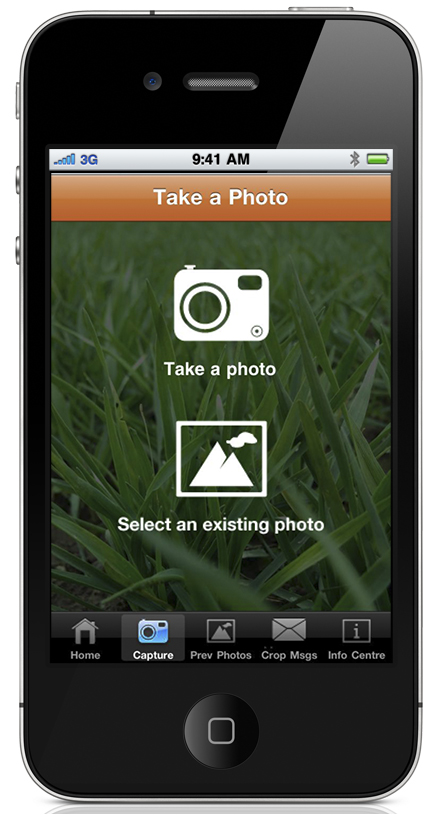
A new Canopy Assessment Tool (CAT) App specifically for the iPhone has just been launched by BASF for the 2011 season. The mobile version will accompany and replicate the online CAT (see www.pgrplus.basf.com) launched last year. It can be downloaded with immediate effect from iTunes.
Developed, trialled and calibrated in association with ADAS, the new CAT App for iPhone allows the user to take a photo of their wheat canopy at GS30/31 and the GAI (Green Area Index) will be automatically generated in the field. From this GAI assessment, with information on the variety grown and predicted yield, the crop’s lodging risk in terms of a Lodging Resistance Score (between 1 and 9 where 1 is low and 9 is high) can be calculated and an indication of the crop’s N content in kg/ha given. The information provided by the CAT will suggest a BASF PGR programme tailored to that individual field risk at the time of taking the photograph. The crop N content helps to estimate the fertiliser requirement when using methods such as the RB209 Fertiliser Guide and GrowHow’s N-Calc System.
"The BASF CAT is a revolutionary tool to help farmers and advisors protect their yield by assessing crop lodging risk. It is an easy to use practical aid, allowing appropriate PGR programmes to be devised and calculating crop nitrogen requirements accurately. It helps to justify inputs and is very much a part of an on-going ICM approach. Taking the CAT tool on to the mobile interface makes the tool faster and more flexible and it was the next obvious innovation. I would encourage growers and advisors to have a go with the CAT online or the new App this spring," says BASF’s Sarah Mountford-Smith.
Sarah explains the science behind the CAT. "The size of the wheat canopy in the spring is a critical indicator for decisions about nitrogen and plant growth regulators and measuring the GAI, the amount of green tissue per m2 of ground, is one accurate way of measuring canopy size. At GS 30, ADAS research has shown that each 0.5 unit increase in GAI above a GAI of 1.25 reduces the variety Lodging Resistance Score, as described in the HGCA Recommended List, by 1 point. At GS 31, the critical GAI above which lodging risk increases is 1.75."
"Higher yielding crops have a greater lodging risk as a result of heavier ears. It has been estimated that each tonne per hectare increase in yield above 9 t/ha reduces the variety Lodging Resistance Score by 0.5 points. Knowing the GAI at growth stage 30 or 31, together with the Lodging Resistance Score of the variety and an estimate of the crop’s yield potential can be used to predict the lodging risk and the subsequent need for a PGR. We also know that each unit of GAI is equivalent to a crop N content of 30 kgN/ha. So assessing how much N a crop has taken up in the spring is needed to estimate the N fertiliser requirement of crops."
Ms Mountford-Smith advises on how to get the best from the CAT. "It is very simple to use, made even easier by the mobile App. First take a photo of wheat between growth stage 30 up to and including growth stage 31 either on iPhone App or using a digital camera. Photographs should be taken directly above the crop. Although the area of crop photographed is not critical, a 1 metre x 1 metre area is perfectly adequate, but choose an area representative of the whole field. Avoid taking photographs on sunny days as this can cause too many shadows. The quality of the camera is less important - a camera phone is fine. If you are using the online version, upload your photos to www.pgrplus.basf.com web site. If using the new App, field photos are processed immediately or can be saved and processed at a more convenient time."
"The iPhone App will automatically generate an assessment of GAI, Crop N and subsequent report there and then in the field. The App has a save function for crop photos and associated crop reports and it automatically records the location by GPS. Another feature is the ability to export the risk assessment by email to customers or colleagues at the touch of a button."
Sarah explains that the GAI classifications from the CAT are based on a ’traffic-light’ system, with an appropriate PGR programme assigned to output. "For example if the GAI is classified as Green then the calculated Lodging Resistance rating from the CAT is high i.e. the risk to lodging is low. If the GAI is at yellow and the crop had a medium Lodging Resistance risk of, say, 6 a suitable programme would be 0.6-0.8 l/ha of Canopy plus 1.2 l/ha of 3C Chlormequat 720 at GS 30-32 followed by 0.75 l/ha of Terpal or 0.6-0.8 l/ha of Canopy at GS 37-39. If the GAI was at red and the crop had a very low Lodging Resistance risk of, say, 4, the programme needs to be more robust and so might be 0.8-1.0 l/ha of Canopy plus 1.2 l/ha of 3C chlormequat 720 at GS 30-32 followed by 1.5 l/ha of Terpal at GS 37-39."
Summary of the main benefits of the CAT App for iPhone over the on-line tool are:
•The possibility to process photos immediately in the field for an instant crop report.
•Ability to email crop photos and report at the touch of a button
•A GPS mapping function which plots the location of crop assessments on a google map, built into the Apps
•Save function - ability to store photos and reports
•Possibility to process other photographs either captured by the iPhone previously or sent via email & accessed by the iPhone
•Simple and fast interface
